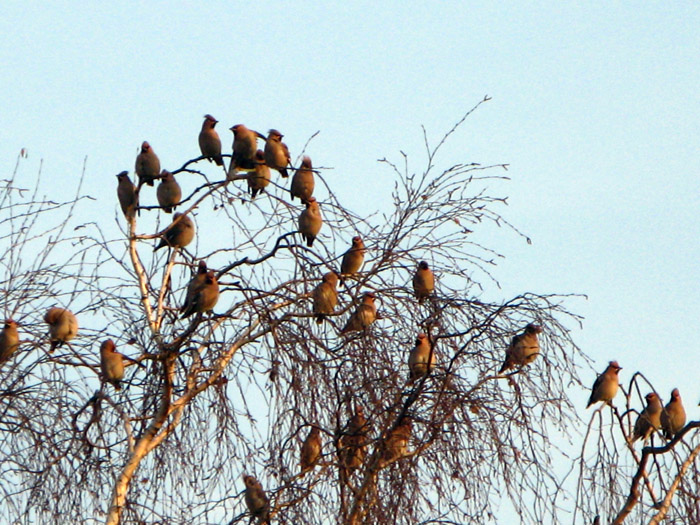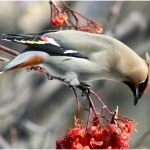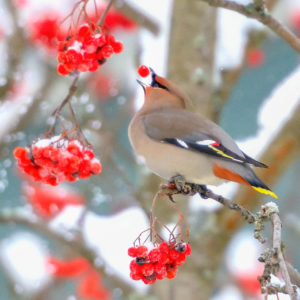Bohemian Waxwings: Behavior Determined by Feeding Habit

Valerie Assinewe, Professional Writing Program Intern
[separator headline=”h3″ title=”All about fruits!”]Bohemian waxwings feed primarily on sugary fruit: in Canada, the fruits are typically mountain ash and juniper. These birds are therefore described as a frugivore. However in the spring and summer months, the Bohemian waxwing also feed on insects such as mosquitoes, midges, dragonflies, mayflies, beetles, and spruce budworms. Like most songbirds, it feeds insects to their young at first but switches to feeding the young berries within a few days.
[separator headline=”h4″ title=”The fruit-eating has defined Bohemian waxwing behavior:”]
• Passing food back and forth is part of the courtship behavior.
• Nesting is near fruit shrubs and trees in the boreal forest.
• Breeding coincides with the ripening of a new season’s fruits (March to late June), which is later than most birds.
• A high-sugary fruit diet generates a strong thirst so these birds require a steady water supply. Breeding and roosting sites are near lakes, streams and swamps.
• Waxwings are gregarious almost year round, except in the breeding season, spending most of their lives in a flock. Flocks are usually smaller in the summer and larger in the winter. They can sometimes number upward to 3000 birds, but most flocks are between 50 and 300 birds. Being in a flock makes for good survival strategy: the numbers of individuals find food faster, more eyes can watch for predators, and flying as a group makes it harder for a flying predator, i.e. falcons and hawks, to catch one bird.
• The lack of territory means that the Bohemian waxwing does not have a true song.
 • From fall to early spring, waxwings are on the move as they forage for food—thus their name “Bohemian” that describes their wandering and vagrant ways. Winter distribution is dependent on food availability and may change from year to year.
• From fall to early spring, waxwings are on the move as they forage for food—thus their name “Bohemian” that describes their wandering and vagrant ways. Winter distribution is dependent on food availability and may change from year to year.
• Flocking Bohemian waxwings are very vocal—thus the species epithet “garrulous”—with call types used in different social contexts that appear to have diverse and subtle meanings.
• Bohemian waxwings often forage and roost with other birds.
• Bohemian waxwings are important seed dispersers: the seeds of the eaten fruit pass through the digestive system and since the waxwings move through a wide area the seeds get widely dispersed within good fertilizer i.e. the rest of the bird poop.
[separator headline=”h4″ title=”Attracting Bohemian Waxwings:”]

Bohemian Waxwing by Randen Pederson
• Plant Mountain ash, Winterberry, Crabapple, Honeysuckle (native species), Serviceberry, raspberry, roses with small hips, Cotoneaster, Dogwoods, Cedar trees, Junipers, or Mulberries.
• Provide birdbaths, especially in winter.
• Provide berries, apples or raisins in feeders.

